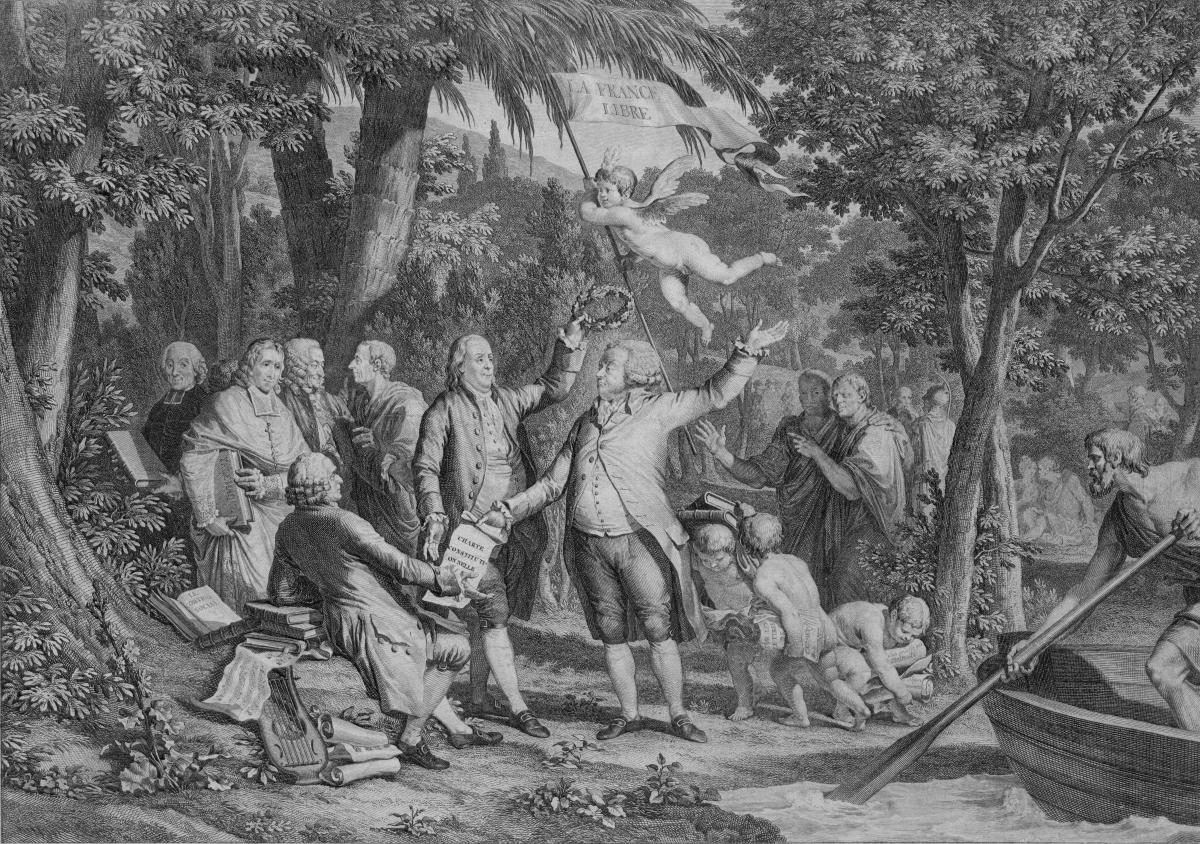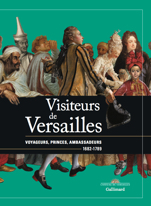19 March of the year 1778: the monarchy to the rescue of a republic
We have come such a long way since, in September 1776, Mr. Deane asked us in the name of an American ‘Congress’ to negotiate a purchase of weapons and uniforms! Who would have been able to imagine that the autodidact physician and printer who accompanied him would become the center of attention of all of Versailles, and sign a treaty of allegiance between a group in rebellion against its King and one of the oldest monarchies in Europe?
What a character this Benjamin Franklin is! For it is of course about him I write. He was already well known among scientists in Versailles and Paris for his invention of the lightning conductor, and this talented autodidact was able, upon his arrival, to renew acquaintances he made during his first visit to Versailles during the reign of Louis XV.

Benjamin Franklin (1706-1790) by Joseph Siffred Duplessis
© The Metropolitan Museum of Art, New York
This portrait, painted in 1778 by Joseph-Siffred Duplessis, one of the favourite painters of the Court, depicts the strong impression that Benjamin Franklin made at Versailles. He is shown here as an unassuming man, modestly dressed. But we should not be deceived, because his importance is expressed through a frame laden with symbols. A crown of laurel leaves, a rattlesnake, a Phrygian cap and a lion’s skin serve as clues to Franklin’s personality.
At the head of his delegation, he finds in the fertile spirit of our age the support that he was hoping for. And we are seeing a veritable bout of Franklinomania arise: women wear ‘lightning dresses’ in homage to his invention of the lightning conductor. I have lost count of the number of young lieutenants who dream of setting off for the New World in the footsteps of the marquis de La Fayette, who people say needed only one dinner to be persuaded to leave to fight alongside the insurgents.
The Court’s enthusiasm for the representatives of a people rising up against their monarch caused some reticence from our King, who is taking the affair very seriously indeed. That was why we met many times in his appartments to discuss this pressing matter.
While we were secretly meeting the envoys from the Congress, he spent many hours studying the question with reports, letters and other books from his library. While we were negotiating in secret, Louis XVI composed a truly beautiful letter to the King of Spain asking him not to leave France alone to make this decision that was so heavy with consequences: open war against the world’s most powerful navy.
It was the news of victory at Saratoga, which reached us shortly before the arrival of the American delegation, that swept away our King’s remaining doubts.
Our monarch has decided to negotiate a trade agreement with the delegation and to receive it as an official ambassador in order to hand the Americans the treaties personally…
This audience will take place tomorrow!
22 March of the year 1778: we have witnessed a nation’s birth
I must tell a story of that visit that we made with what has since become an official delegation. It was on the morning of 20 March that we found ourselves together: Croÿ, myself and the ambassadors led by the famous Franklin. From afar, I had already glimpsed his silhouette, then, as they approached, his features. Benjamin Franklin has the face of a great man. Wearing a hat on his white, unpowdered hair, he presented himself in the middle of our Court’s splendour dressed as an American farmer. His brown woollen cloth waistcoat stood out from the embroideries and perfumes of the small crowd that was already building up around him, attracted by the originality of the scene. Everyone was struck by disbelief to see this simple and peaceful man headed straight towards his destiny in the sumptuous scene of flannel and precious stones that is the fashion of our Court.

Mirabeau arrive aux Champs Élysées
© Château de Versailles
Made in 1792 - after the French Revolution - this engraving is an allegorical depiction of thinkers of the Age of Enlightenment. It brings together beneath a cherub carrying the flag of free France the people considered as having allowed for democracy to emerge. There we can find Rousseau, Voltaire, Montesquieu and Benjamin Franklin, who is placing of Mirabeau’s head a crown of laurel leaves, a symbol of triumph inherited from the Roman Empire.
We entered the chamber of our King, to whom I presented the three visitors in turn. His Majesty then pronounced a sentence that History has recorded:
« I would like you to assure the Congress of my friendship. I hope that this will be for the good of our two nations. »
To my ears, these words resounded like cannon fire in the calm morning air. If the treaties were already signed and war with England was unavoidable, there is a gulf between seizing a trading or military opportunity and giving birth to an independent democracy on the other side of the ocean.
Through these words our King crossed the Atlantic like Caesar crossed the Rubicon, bringing France into the fate of the American adventure. In the simplicity of that phrase, we had just witnessed, greatly moved, a nation’s birth.
We were therefore still stunned when we heard resonate, like an echo, Mr Franklin’s response – sobre, measured and sincere: “Your Majesty can count on the gratefulness of Congress and on its faithfulness in the engagements that it is undertaking.”

Constitution of the thirteen United States of America
© Bibliothèque Municipale de Versailles / Christophe Fouin
This constitutions translated into French, “the most spoken language in Europe”, by Louis-Alexandre, the Duke of La Rochefoucauld d’Anville, were part of Franklin’s strategy to inform as best as possible the European courts of what was happening in America. Two copies were distributed to all the embassies for that reason. Two copies bound in red and marked with the French coat of arms were given to Louis XVI and Marie-Antoinette.
While I was presenting the people who were in attendance, I thought I saw Mr Lee and Mr Deane appear a little disappointed by soberness of the protocol. A crueler pen would written that, with their powder and their outfits ‘à la française’ they were hoping for the splendor of the time when ambassadors who travelled across the oceans were welcomed in gold and silver.

Medal of the Order of Military Merit awarded to Scottish sailor John Paul Jones, who was presented to Louis XVI by Benjamin Franklin.
© Paris - Musée de l'Armée, Dist. RMN-Grand Palais / image musée de l'Armée
As for Benjamin Frankin, he seemed to hear the wheels of history turn in the calm of the King’s words. His face without makeup, which normally had the air of a statue of a classical philosopher, was glowing, as if rejuvenated by the importance of the moment. It is in that face that I understood the promise of this new America that we had seen be born in this first day of spring. An America that, like him, believes in the power of reason and work, a nation of cultivated and simple autodidacts that gives things value based only on their use or the value that they bring. A nation that was marching into the century, free and conquering, under the protective wing of one of the oldest monarchies of the continent!
The ‘affairs of England and America’, to use the name of a publication from the time, had some impact on the Court. From the enthusiasm of a large portion of the youth, embodied by the marquis de La Fayette, to how the women dressed, the American delegation had great success. It was able to defend its views so well that France’s involvement in the War of Independence was total. And so victory came, little by little. It ended with the signing in 1783 of the Treaty of Independence between France, the United States and England and which took place in … Versailles.



